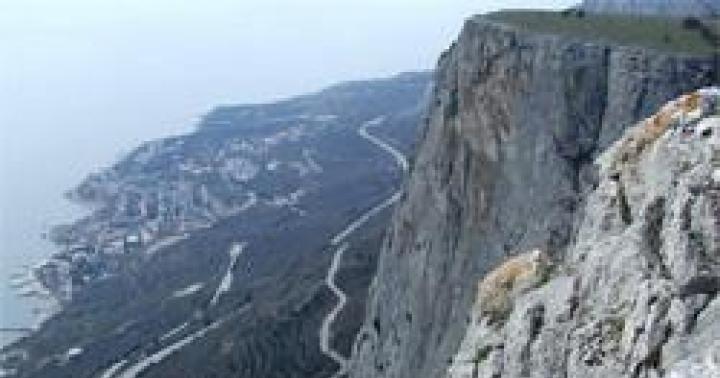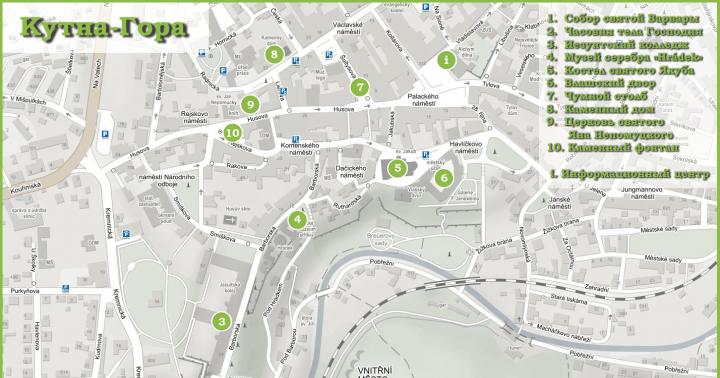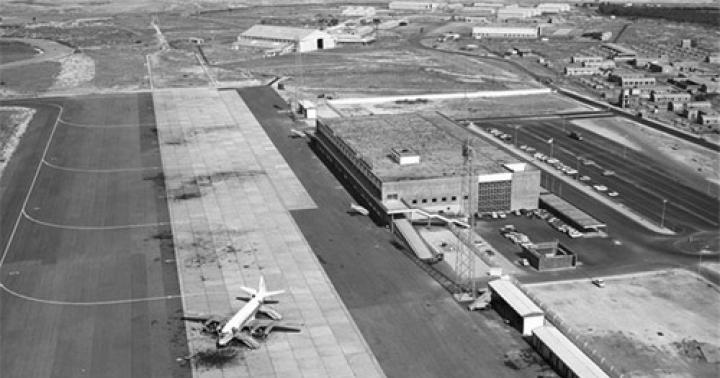Rare travelers reach this island in the South Atlantic Ocean. There is no airport, and the nearest country, South Africa, is 2,816 kilometers away.
Them more interesting story island, which was first described by the Portuguese Tristan da Cunha in 1506. True, he did not dare to land on shore. In 1810, the first permanent settlers arrived from Salem, Massachusetts. Four men, led by Jonathan Lambert, named the place Refreshing Island. Three of them had died by 1812, and the only survivor, Thomas Curry, remained to live on the island and took up farming.
The distance of the island from the mainland.

View of Tristan da Cunha from the ocean.
In 1815, the island of Tristan da Cunha was annexed by the British. All because next door - on the island of St. Helena (2161 kilometers away) - Napoleon was languishing in prison. The British were afraid of rescue operations, and the islands were of strategic importance on the way to Indian Ocean(The Suez Canal will not be dug until 1869).
Now the island is considered part of the British overseas territory of St. Helena, Ascension and Tristan da Cunha (there are 14 such territories in total - from the famous Gibraltar and Falkland Islands to Pitcairn and Anguilla). The island belongs to Great Britain, but is not part of it. The queen has never set foot on the island, and setting foot on this island for a non-inhabitant is an extremely difficult task. Fishing boats from South Africa come here only a few times a year. They are equipped with seats for passengers.

Island flag



City map
As of 2016, the island is inhabited by 268 residents from just seven families (there is even a family tree posted on the island). There is little work here, so many government jobs have been created for residents: police, customs, environmental, environmental and agricultural services. And every resident of the island of Tristan da Cunha is a farmer who owns his own potato field. To ensure that everyone's standard of living remains average, a family is allowed to have a maximum of two cows. No one on the island pays taxes, but the population receives royalties from the sale of seafood.
The only settlement has the wonderful name Edinburgh of the Seven Seas. Locals, however, simply call it The Settlement.

View of Edinburgh of the Seven Seas



Ordinary house in Tristan da Cunha
In 2005, the UK gave the island its own postcode (TDCU 1ZZ) to make it easier for residents to order goods online. True, there is no cell phone service here. From 1998 to 2006, 64 kilobit Internet was available via satellite phone, but the high cost and poor quality of service forced island residents to abandon it. Now the Internet is only available in cafes, and this is perhaps the most remote Internet cafe in the world from civilization.
Television is available in the form of two BBC channels, so news reaches island residents somewhat faster than in 1919. Then a passing ship (the first since 1909) informed them of the results of the First World War.




Local

Bus stop
Read more:
Report at the Vinsky Forum for 2013
Island of Tristan da Cunha. Wikipedia
Island of Tristan da Cunha. Official site

We live in a fascinating world. There are still many secrets on the planet to be discovered. The more one studies the world, the more curious he becomes. There is one very interesting place– a remote group of volcanic islands in South Atlantic called Tristan da Cunha. It's also called main island archipelago. This place is ideal for those who want to take a break from the noisy city life.
Tristan da Cunha is the most remote inhabited archipelago in the world


It was not until 1767 that a complete exploration of the island of Tristan was carried out. The crew of the French corvette stayed on it for three days. And the island remained uninhabited until the 19th century.
In 1810, a man named Jonathan Lambert arrived from Massachusetts and settled on the island. He immediately demanded ownership of the archipelago. He arrived in December of that year with two other men and claimed the islands as his own, calling them the Recuperation Islands. However, two years later, only Thomas Curry remained on the island. He was a farmer. In 1816, the archipelago was annexed by the United Kingdom.
The only settlement of Tristana da Cunha is located in the north of the island, and is called Edinburgh of the Seven Seas



Photo: Brian Gratwicke/flickr (https://creativecommons.org/licenses/by/2.0/)
The islands are home to volcanoes that have erupted in the past. So, when large eruptions, landslides and an earthquake occurred in 1961, the entire population left for England. The men reportedly eventually grew tired of city life and the English weather, and returned to Tristan when experts confirmed that the danger had passed.
Islands of Tristan da Cunha ... Wikipedia
Saint Helena, Ascension and Tristan da Cunha ... Wikipedia
Tristan da Cunha: Tristan da Cunha (islands) archipelago in the southern part Atlantic Ocean. Cunha, Tristan and the famous Portuguese navigator ... Wikipedia
- (Tristan da Cunha) a group of 4 volcanic islands in the southern Atlantic approx. Possession of Great Britain. The area itself large island 117 km². Population of St. 300 people (1988). The main population center is Edinburgh. Fishing, hunting... ... Big Encyclopedic Dictionary
- (Tristan da Cunha) about in in south. parts of the Atlantic Ocean, possession of Great Britain. Until issue own brands in 1952 used. stamps about the Great Patriotic War of St. Helena and the Ascension, as well as South Africa and Great Britain. A series prepared in 1946 by local authorities... ... Large philatelic dictionary
- (Tristan da Cunha), a group of 4 volcanic islands in the South Atlantic Ocean. Possession of Great Britain. The area of the largest island is 117 km2. population over 300 people (1988). Basic locality Edinburgh. Fishing,... ... encyclopedic Dictionary
Tristan da Cunha- (Tristan da Cunha), a group of 4 volcanic islands, in the South Atlantic Ocean (37°06"S and 12°01"W). Administratively (since 1938) part of the British dominion. Area 209 km2 (including the largest and most inhabited... ... Encyclopedic reference book "Africa"
- (Tristan da Cunha, named after the Portuguese navigator Tristão da Cunha, who discovered these islands) a group of 4 volcanic islands in the southern Atlantic Ocean (37°06 S and 12°01 W). Belongs to Great Britain. Square… … Great Soviet Encyclopedia
- (Tristan da Cunha) an island in the South Atlantic Ocean, owned by the British. 37°6 S la., 12°2 w. d. The shape of the island is round, the surface is 116 sq. km, 61,000 inhabitants. Consists of one cone-shaped mountain 2300 or 2540 m high, steep... ... Encyclopedic Dictionary F.A. Brockhaus and I.A. Efron
Tristan da Cunha Islands Saint Helena Great Britain ... Wikipedia
Books
- Winter is ending. Stories, Andrey Kalinin. A book for those who are looking for their path and believe that any winter ends sooner or later. 14 stories about a variety of people: from the first number on the Forbes list to a young resident of the island...
Tristan da Cunha is the most remote inhabited island in the world. The nearest land - the island of St. Helena - is more than 2 thousand kilometers, and the nearest coast of the African continent is more than 2,700 kilometers. 272 people permanently live on the island. the only island archipelago with a permanent population.
Tristan da Cunha is an archipelago in the South Atlantic Ocean, part of the British overseas territory of Saint Helena. Along with Easter Island, it is one of the most remote inhabited places on Earth. Located 2816 km from South Africa, 3360 km from South America and 2161 km south of St. Helena.


Tristan da Cunha is a group of small volcanic islands in the South Atlantic Ocean, part of the British dependency of St. Helena. The islands are located within latitude 37°6' south and longitude 12°1' west. The total area of the islands is approximately 202 square meters. km. On Tristan da Cunha, the largest (98 sq. km) and the only inhabited island of the entire group (population in 1988 - 313 people), at an altitude of 2060 m there is a volcano that was silent until 1961, when the its eruption. Most of the island's inhabitants are descendants of British soldiers who were stationed on Tristan da Cunha during Napoleon's imprisonment on St. Helena, while some residents are descendants of whaling ship sailors who once settled on the islands. The inhabitants of the islands are engaged in agriculture, fishing and animal husbandry. Since 1942, the island has housed a British radio and weather station. Before 1948, there was no organized form of government on the islands. In 1950, the first Governor of St. Helena was appointed, and in 1952 general elections to the Island Council were held. Other islands in this group: Gough, Inaccessible (Inaccessible) and Nightingale (Nightingale). The islands were discovered in 1506 by Portuguese sailors under the leadership of Admiral Tristro Cunha and were annexed by Britain in 1816. During the volcanic eruption in 1961, all residents of the islands were evacuated, but later, in 1963, they returned to their native places.


Tristan Da Canha is home to a population of 270 very isolated people, with an economy based in the fishing industry. The climate of the islands is temperate oceanic, rainy and windy. On Gough Island average monthly temperature ranges from +9°C to 14.5°C, at northern islands- from +11 °C to 17.5 °C. Annual precipitation ranges from 2000 mm in the north to 2500 mm on Gough Island.

Islanders often find themselves hostage to Atlantic storms: wind gusts of almost 190 km per hour were once so strong that they lifted cows and sheep into the air, and they fell into the ocean and died there...

The island of Tristan da Cunha is the only island in the archipelago with a permanent population. The main settlement of the island is Edinburgh of the Seven Seas in the northwestern part of the island. Other settlements are temporary and are scientific bases and meteorological stations. The population of the island is about 300 people. Tristan da Cunha is an island of volcanic origin that appeared about a million years ago. The island is located highest point archipelago - Queen Mary (Queen Mary) peak, 2055 meters above sea level. In winter, the top of the mountain is covered with snow. Queen Mary is a volcano that has erupted several times since the island's discovery. The island of Tristan da Cunha has a rocky coast and mountainous terrain, there are numerous ravines that local residents called "gorges" ("gulches"). The only territory of the island adapted for permanent human life is the northern and northwestern part. You can also land there from the sea without much risk.

And this is the “breakfast” of the inhabitants of this island - Genuine Tristan Lobster Tails - they say it is very tasty!

The island now has a mini market, radio station, cafe, video store and swimming pool. Tristan is connected to the world by one telephone and fax in the Manager's Department, and is visited once a year by the only mail ship in the world. This ship brings not only mail, but also canned food, videos, books and magazines, and medicines.





The island is inhabited not only by people, but also by an albatross chick:

And also penguins:

Some more photos of the inhabitants of this remote island





In continuation, read also about the wildest places on Earth, which also includes the island of Tristan da Cunha.
Saint Helena, Ascension and Tristan da Cunha ... Wikipedia
This term has other meanings, see Tristan da Cunha. Islands of Tristan da Cunha ... Wikipedia
- (Tristan da Cunha) about in in south. parts of the Atlantic Ocean, possession of Great Britain. Until issue own brands in 1952 used. stamps about the Great Patriotic War of St. Helena and the Ascension, as well as South Africa and Great Britain. A series prepared in 1946 by local authorities... ... Large philatelic dictionary
Tristan da Cunha: Tristan da Cunha (islands) is an archipelago in the South Atlantic Ocean. Cunha, Tristan and the famous Portuguese navigator ... Wikipedia
- (Tristan da Cunha) a group of 4 volcanic islands in the southern Atlantic approx. Possession of Great Britain. The area of the largest island is 117 km2. Population of St. 300 people (1988). The main population center is Edinburgh. Fishing, hunting... ... Big Encyclopedic Dictionary
- (Tristan da Cunha), a group of 4 volcanic islands in the South Atlantic Ocean. Possession of Great Britain. The area of the largest island is 117 km2. population over 300 people (1988). The main population center is Edinburgh. Fishing,... ... encyclopedic Dictionary
Tristan da Cunha- (Tristan da Cunha), a group of 4 volcanic islands, in the South Atlantic Ocean (37°06"S and 12°01"W). Administratively (since 1938) part of the British dominion. Area 209 km2 (including the largest and most inhabited... ... Encyclopedic reference book "Africa"
- (Tristan da Cunha, named after the Portuguese navigator Tristão da Cunha, who discovered these islands) a group of 4 volcanic islands in the southern Atlantic Ocean (37°06 S and 12°01 W). Belongs to Great Britain. Square… … Great Soviet Encyclopedia
- (Tristan da Cunha) an island in the South Atlantic Ocean, owned by the British. 37°6 S la., 12°2 w. d. The shape of the island is round, the surface is 116 sq. km, 61,000 inhabitants. Consists of one cone-shaped mountain 2300 or 2540 m high, steep... ... Encyclopedic Dictionary F.A. Brockhaus and I.A. Efron
Islands of Tristan da Cunha Flag of the islands Coat of arms of the islands ... Wikipedia
Books
- Winter is ending. Stories, Andrey Kalinin. A book for those who are looking for their path and believe that any winter ends sooner or later. 14 stories about a variety of people: from the first number on the Forbes list to a young resident of the island...


